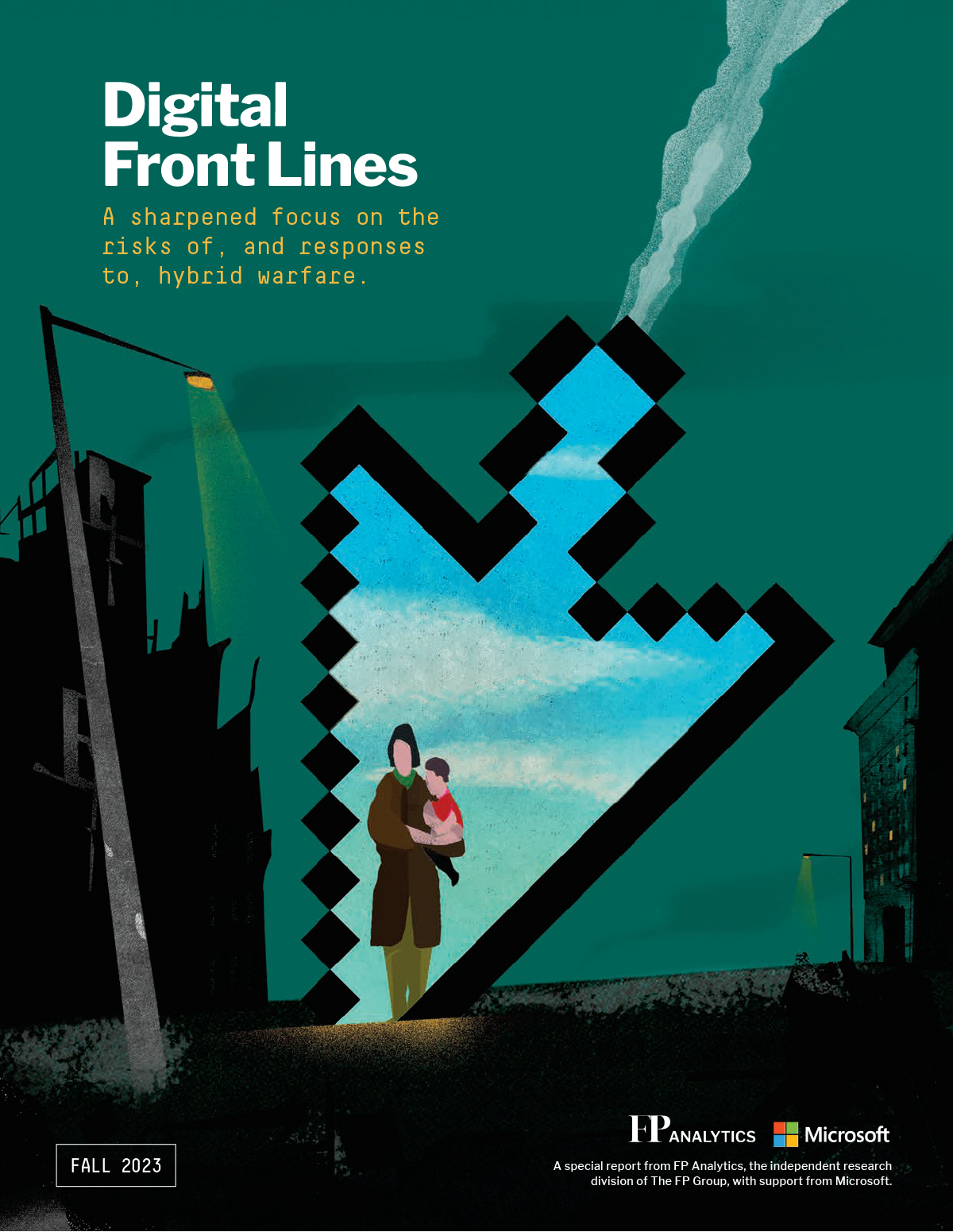In an interview with FP Analytics, Ambassador Sorin Ducaru, Director of the European Union Satellite Centre (SatCen), discussed the risks that cyber operations pose to space-based assets and capabilities, particularly during armed conflict, and the multilateral and multisectoral efforts to address these challenges.
FP Analytics (FPA): What risks and vulnerabilities do cyber operations present to outer space assets and capabilities during armed conflict? What are SatCen’s priorities for countering those risks?
Ambassador Sorin Ducaru (SD): Like any other digitalized critical infrastructure, space infrastructure is vulnerable to cyberattacks. These vulnerabilities pose significant risks not just for space assets themselves but also for ground-based critical infrastructure and civilians.
To understand the specific cyber vulnerabilities of space systems, one needs to consider the different segments of infrastructure that can be targeted by cyberattacks. Command intrusion cyberattacks could manipulate or destroy the basic controls of a spaceship. Cyberattacks could also target the payload controls, for example, by generating denial-of-service effects to overload systems. Links between space assets could be targeted and spoofed by disguising communication from an untrusted source as a trusted one. Finally, but perhaps most likely, cyberattacks could be used to infect ground systems such as satellite control centers. There is, clearly, no shortage of options for cyber attackers against space systems. Therefore, every key component at any level of this complex architecture of space systems needs to be hardened and protected from cyberattacks.
For older, legacy space systems, with low-level intrusion protection, this is a particularly difficult problem. For new systems, with the increasing commercialization of space and the exponential growth in launches and satellites, the cyberattack surface is growing exponentially as well, so cybersecurity by design is a key requirement.
SatCen’s core mission is to provide geospatial intelligence analysis for European Union bodies, EU member states, and EU partners—international organizations such as the United Nations, the Organization for Security and Co-operation in Europe, the Organisation for the Prohibition of Chemical Weapons, and/or third states—based on a special mandate from the EU Council. It is therefore a ground-based organization relying on secure, trustworthy data, mainly from space sensors, for its work. The reliability of data and cybersecurity of SatCen’s own systems are therefore key. To that end, we use multiple satellite data sources from trusted providers and employ a multilayer cybersecurity protection architecture. Above all, our most important assets are indeed our highly professional staff.
FPA: What are the most pressing concerns and threats cyber operations pose to cooperation and peace in outer space? How does SatCen work with other multilateral institutions to address or mitigate risk?
SD: It is important to have a holistic view of threats to space assets. Examples of antisatellite tests; cyberattacks; and spoofing, jamming, or laser dazzling of telecom or navigation and positioning satellites show the dangers of space abuse. Evolving technologies like orbit rendezvous can be exploited to approach a satellite and spy on it or even damage its functionality. Cooperation and peace in outer space is threatened by a mix of these manifestations—malicious cyber operations being just one.
Neither outer space nor cyberspace benefits from much dedicated international regulation. The 1967 Outer Space Treaty’s principles regulate space as a common domain, advocate for its peaceful use, and prohibit the placing of weapons of mass destruction in space. On cyberspace, there is no dedicated international treaty. However, multilateral institutions have, in recent years, begun to address the challenge of malicious behavior in outer space. The “Guidelines for the Long-Term Sustainability of Outer Space Activities,” approved by the U.N. Committee on the Peaceful Uses of Outer Space in June 2019, represents a first milestone toward fostering space cooperation and peace through a rule-based system. The EU’s initiative for Safety, Security, and Sustainability of Outer Space (3SOS), also launched in 2019, aims to develop a sustainable operational space environment. The U.N. Open-ended Working Group on cybersecurity as well as the U.N. Governmental Group of Experts have been engaged in consultation over the past few years to support responsible behavior, transparency, confidence, and cooperation in cyberspace. In addition, cybersecurity policies, standards, action plans, and cooperation structures among computer emergency response teams have been developed and updated at EU and NATO levels. However, all of these initiatives would benefit from more focus on the specific challenges cyberattacks pose to space assets.
FPA: How has the war in Ukraine affected priorities for SatCen and other multilateral space-focused institutions in relation to cyber operations in space?
SD: The war in Ukraine has increased public awareness on the relevance of space assets to our daily life, to our economies, to our societies, during conflicts, in our humanitarian support efforts, and in the conduct of military operations. Modern satellite communications (such as those provided by Starlink) have proved essential when ground communications infrastructure has been compromised, disabled, or physically damaged by military attacks. Satellite imagery has been also instrumental in providing early warnings about the positioning of military equipment; defense planning; assessing battle damage or the impact of actions such as the destruction of the Kakhovka dam; providing humanitarian relief; and documenting war crimes, like those in Bucha.
For organizations whose activity is linked with the space domain, such as SatCen, these benefits have been obvious for a long time. I would not say that the war in Ukraine has changed our cybersecurity priorities, but it has emphasized the importance of considering not just the sustainability and safety of space infrastructure but also relevant security and defense measures. Space is, today, not just a competitive and increasingly congested environment but also a contested domain, meaning that the protection of our space assets needs to take into account potential targeted threats from adversaries. Such threats might impact the service, functionality, or reliability of space infrastructure or inflict physical damage. From a cybersecurity perspective, it is therefore key that all the components—both space- and land-based—of our space infrastructure are “hardened” with increased resilience. The new environment introduced by the war and reflected by a contested space domain implies greater risk management and requires the prioritization of investment in both technology and expert skills to address this concerning threat landscape.
FPA: Are there any promising partnerships and collaborations emerging to safeguard space assets and capabilities from cyber operations and hybrid warfare? Where do you see room for greater cooperation and collaboration with the private sector?
SD: In recent years, there have been important cooperative initiatives among the EU and NATO members and with key partners, such as Ukraine, to increase general resilience to cyber or hybrid attacks. The NATO Cooperative Cyber Defence Centre of Excellence in Tallinn, Estonia, and the European Centre of Excellence for Countering Hybrid Threats in Helsinki are valuable examples of operational partnership and cooperation. In 2016, the EU and NATO signed a technical arrangement on cyber cooperation, which includes the exchange of relevant information, analysis, training, and exercise. The two organizations have also developed programs to support cyber resilience and capacity building in partner states across the globe. In 2023, the space domain was included in the updated Joint Declaration on EU-NATO Cooperation. While these initiatives are not focused specifically on safeguarding space assets from cyberattacks, strengthening cybersecurity and building resilience in general can extend to ground or orbit components of space infrastructure.
Cooperation with the private sector is key, given its leading role in the development of relevant technology and infrastructure. About 80 percent of the global cyber infrastructure is owned and operated by the private sector, while commercial space infrastructure is experiencing exponential growth. NATO established a dedicated cybersecurity partnership with the tech industry in 2014, and the signatories of the 2018 Paris Call for Trust and Security in Cyberspace include states, nongovernmental organizations, and private-sector representatives, reflecting a truly multistakeholder approach. The NASA-led Artemis Accords, launched in recent years, include a growing number of national space agencies among their signatories and put a great emphasis on cooperation between governments and the private sector for the safety and security of space assets. Public–private cooperation needs to be enhanced to address the increasing threats we face in cyberspace and outer space.
Ambassador Sorin Dumitru Ducaru has been the Director of the European Union Satellite Centre (SatCen) since June 2019. He previously held the positions of NATO Assistant Secretary General and head of the NATO Emerging Security Challenges Division, as well as the positions of Romania’s ambassador to NATO, the United States, and the United Nations in New York. Ambassador Ducaru’s professional background reflects a blend of technical and political/social studies, and he has been engaged with bridging the technology–policy gap and addressing the impact of technology on security. He is a member of the European Council on Foreign Relations, an advisory board member of the Tallinn-based NATO Cooperative Cyber Defence Centre of Excellence, and a former Senior Fellow at the Hudson Institute in Washington, D.C.

 with support from
with support from




